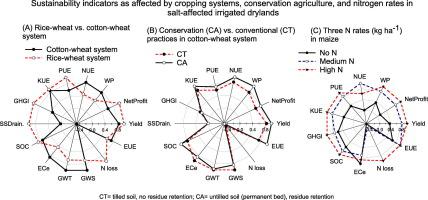Agricultural Systems ( IF 6.6 ) Pub Date : 2022-02-16 , DOI: 10.1016/j.agsy.2022.103390 Krishna Prasad Devkota 1 , Mina Devkota 2 , Meisam Rezaei 3 , Roland Oosterbaan 4

|
CONTEXT
Declining water quantity and quality and poor land, water, and crop management practices are leading to increasing soil salinity, land degradation, desertification, and threatening the overall sustainability of the crop production system in irrigated drylands. Assessments of salinity dynamics and sustainability indicators under alternative agricultural practices are needed to identify the right combination of practices that improve sustainability while minimizing land and environmental degradation.
OBJECTIVE
The objective of this study was to assess the potential of conservation agriculture (CA)-based practices, water-saving irrigation, water quality, and nitrogen (N) fertilizer rates for improving the sustainability of rice-wheat (RWS) and cotton-wheat (CWS) systems in salt-affected irrigated drylands.
METHODS
The study included mixed-method approaches of two years of field experiments, soil profile and groundwater salinity simulation using Hydrus-1D model, and multi-criteria trade-off analysis for the holistic assessment of alternative innovations in RWS and CWS. The treatments in experiments were composed of a combination of CA-based practices, water-saving irrigation and N rates. Fourteen sustainability indicators computed from experiments and simulation were compared to evaluate the sustainability of those cropping systems and to reveal the potential of those practices for improving sustainability.
RESULTS AND CONCLUSIONS
Compared to the initial conditions, the soil salinity decreased in both cropping systems, while the reduction rate was much higher in RWS than CWS (by 28%). In RWS, the conventional treatment had the lowest salinity level, while in CWS, CA (permeant bed + residue retention) had the lowest. RWS raised the groundwater table by 25% compared to CWS. The long-term scenario analysis with Hydrus-1D demonstrated that, with increased irrigation water salinity and soil evaporation rates, soil profile salinity increases by 78% in RWS and 66% in CWS. RWS had a higher net profit (+81%) and soil organic carbon (SOC) (-15%), but lower water productivity (WP) (−147%), nitrogen, and energy use efficiency (EUE) (−46%) than CWS. The CA-based practices in CWS improved sustainability indicators with higher yield and net profit (+20%), WP (+26%), SOC (+456%), and EUE (36%) with decreased soil salinity than in the conventional system.
SIGNIFICANCE
The study attempts to assess the effectiveness of resource conservation technologies such as choice of crop species and cropping systems, and tillage and water and fertilizer management practices for improving sustainability. This study showed the significance of agronomic, soil, and water management practices for minimizing soil salinity. Further, the findings from this study strongly demonstrated the role of CA in sustainable agricultural production particularly under CWS in salt-affected irrigated dryland.
中文翻译:

在受盐分影响的灌溉旱地土壤中管理盐分以实现可持续农业生产
语境
水量和质量的下降以及土地、水和作物管理做法不佳正在导致土壤盐分增加、土地退化、荒漠化,并威胁到灌溉旱地作物生产系统的整体可持续性。需要对替代农业实践下的盐度动态和可持续性指标进行评估,以确定正确的实践组合,以提高可持续性,同时最大限度地减少土地和环境退化。
客观的
本研究的目的是评估以保护性农业 (CA) 为基础的做法、节水灌溉、水质和氮 (N) 肥用量在提高稻麦 (RWS) 和棉麦可持续性方面的潜力(CWS) 系统在受盐分影响的灌溉旱地。
方法
该研究包括两年现场实验的混合方法方法、使用 Hydrus-1D 模型的土壤剖面和地下水盐度模拟,以及用于对 RWS 和 CWS 替代创新进行整体评估的多标准权衡分析。实验中的处理由基于 CA 的实践、节水灌溉和 N 率的组合组成。比较了从实验和模拟中计算出的 14 个可持续性指标,以评估这些种植系统的可持续性,并揭示这些做法在提高可持续性方面的潜力。
结果和结论
与初始条件相比,两种种植系统的土壤盐分都降低了,而RWS的降低率远高于CWS(28%)。在 RWS 中,常规处理的盐度水平最低,而在 CWS 中,CA(渗透床+残留物保留)最低。与 CWS 相比,RWS 将地下水位提高了 25%。Hydrus-1D 的长期情景分析表明,随着灌溉水盐度和土壤蒸发率的增加,RWS 的土壤剖面盐度增加了 78%,CWS 增加了 66%。RWS 的净利润 (+81%) 和土壤有机碳 (SOC) (-15%) 较高,但水生产力 (WP) (-147%)、氮和能源利用效率 (EUE) (-46%) 较低) 比 CWS。CWS 中基于 CA 的实践改进了可持续性指标,具有更高的产量和净利润 (+20%)、WP (+26%)、SOC (+456%)、
意义
该研究试图评估资源保护技术的有效性,例如作物种类和种植系统的选择,以及提高可持续性的耕作和水肥管理实践。这项研究表明了农艺、土壤和水管理实践对减少土壤盐分的重要性。此外,这项研究的结果有力地证明了 CA 在可持续农业生产中的作用,特别是在受盐害灌溉旱地的 CWS 下。



























 京公网安备 11010802027423号
京公网安备 11010802027423号